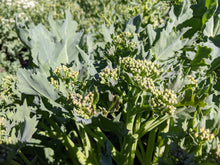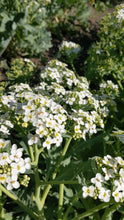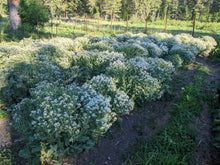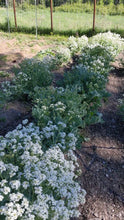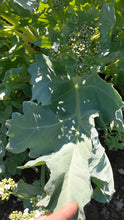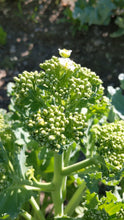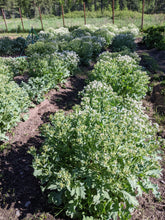'Billington' Seakale
Regular price
$5.00
Sale
Crambe maritima
Origin: Montana
Improvement status: Breeding population
Seeds per packet: ~50
Germination tested 11/2024: 40%
Life cycle: Perennial
Beautiful, fragrant, delicious and low maintenance. Seakale is basically the gold standard for perennial vegetables. This selection is a 3rd generation cross between a variety of parents seedlings from a range of sources including J.L. Hudson, Chris Homanics, William Whitson, and others. The major limiting factors on seakale are its hardiness and often bitter taste profile. This population contains two types with emergence times differing by about two weeks. The earlier emerging types have purple buds and the late emerging ones have green buds. Our source for these seeds, Montana-based breeder Michael Billington, has been selecting for plants with less of the powdery blue quality to the leaves because that seems to be directly related to their bitterness. These plants have been subjected to -10F in arid conditons. The survivors of these weather events are the parent plants for all subsequent breeding work. We're excited to be offering this extra-cold-hardy selection for the first time!
Seakale is a once-popular crop famed in English gardens but which goes largely unnoticed in America, though in certain circles it is finally getting the attention it deserves. Seakale comes from the coasts of northern Europe where it grows in sprawling clumps along the shore. Because this plant evolved on ocean shores it developed some unique characteristics. It is considered a halophyte, meaning it can grow in the presence of salt. This can inform our management because if we spread salt on our seakale beds then we limit weed growth and improve the seakale’s flavor. It also evolved seedpods with a foamy pericarp (like a hull) that helps them float to another location. These seedpods make for a nice crunchy garden snack, like a mustard-flavored pea. Young shoots are often blanched by covering the plant with an upturned terra cotta pot in early spring, so the shoots develop in the absence of sunlight. This makes them less bitter and quite beautiful (some varieties are pink and some yellow under this treatment).
Crambe maritima provides one of the first foods in spring, at which point the shoots are like a mixture between bok choy and asparagus. In late spring it provides the first succulent kale-like leaves (with younger leaves tastier and more tender than older ones). Next comes a profusion of succulent broccoli-like florets. These eventually turn into a sea of white flowers that delight pollinators and noses as it perfumes the air with its beeswax-scented blooms. These edible flowers eventually turn into enjoyable seed pods that are a welcomed addition to any salad or pickled product (they can be brined like capers).
GROWING NOTES: Cold/moist stratify seeds for at least 30 days before planting. Seeds are contained in individual pods which should be carefully removed or at least cracked before planting for uniform germination (Nate likes to use his teeth for this purpose, finding them far easier and less dangerous to control than a knife — cutting into a tiny round ball with a knife is not easy). Start seeds in flats a few weeks before last frost, planting 1/2" deep. Seakale prefers a sunny position and is adaptable to a range of soil types.
You can propagate seakale via seed or root cuttings (called thongs) once established. Simply loosen the surrounding soil and lift the plant. Then take 4” cuttings of the root while paying meticulous attention to which part of the root was closest to the crown because that end of the cutting must be planted upwards at just below soil level. Give the plants 3 feet of space. Alternatively if you are only growing for shoots and florets you can plant them denser to improve yields but make sure to not let the flowerheads mature and branch out as they will crowd themselves and limit production.








